Contemporary Business Economics Report: Theories and Models Analysis
VerifiedAdded on 2022/08/25
|14
|3272
|26
Report
AI Summary
This report delves into essential microeconomic concepts crucial for business operations, focusing on the laws of demand and supply. It analyzes the factors influencing the movement of demand and supply curves, providing examples to illustrate these principles. The report then contrasts classical economic theories prevalent in the 20th century with the Keynesian economic theory, which is more relevant in the 21st century. The comparison includes an examination of how these theories impact business practices and economic management. The report includes an introduction to the concepts, a detailed discussion of the laws of demand and supply, and a comparison between the economic theories of the 20th and 21st centuries. The report concludes with a summary of the key findings and their implications for contemporary business economics.
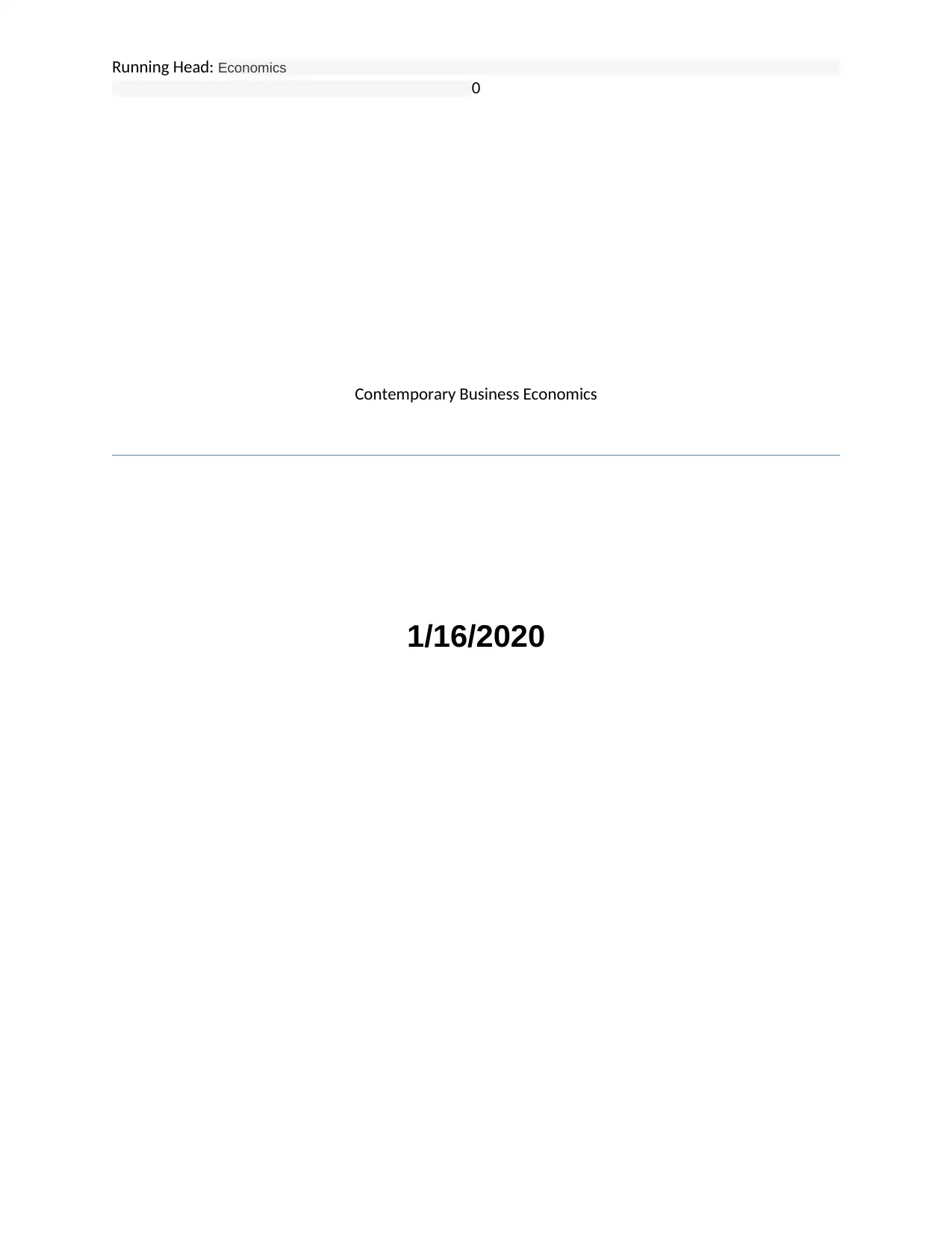
Running Head: Economics
0
Contemporary Business Economics
1/16/2020
0
Contemporary Business Economics
1/16/2020
Paraphrase This Document
Need a fresh take? Get an instant paraphrase of this document with our AI Paraphraser
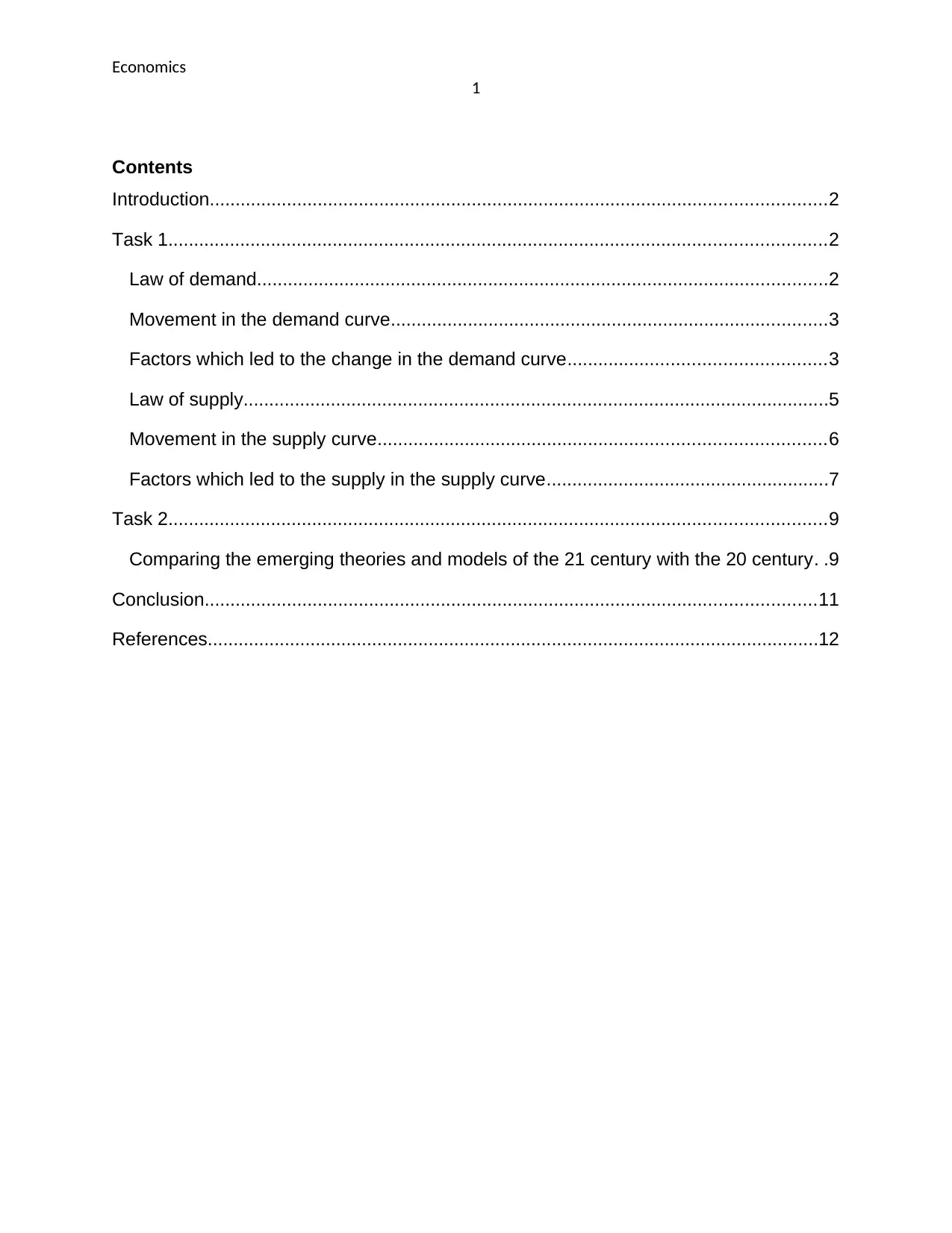
Economics
1
Contents
Introduction........................................................................................................................2
Task 1................................................................................................................................2
Law of demand...............................................................................................................2
Movement in the demand curve.....................................................................................3
Factors which led to the change in the demand curve..................................................3
Law of supply..................................................................................................................5
Movement in the supply curve.......................................................................................6
Factors which led to the supply in the supply curve.......................................................7
Task 2................................................................................................................................9
Comparing the emerging theories and models of the 21 century with the 20 century. .9
Conclusion.......................................................................................................................11
References.......................................................................................................................12
1
Contents
Introduction........................................................................................................................2
Task 1................................................................................................................................2
Law of demand...............................................................................................................2
Movement in the demand curve.....................................................................................3
Factors which led to the change in the demand curve..................................................3
Law of supply..................................................................................................................5
Movement in the supply curve.......................................................................................6
Factors which led to the supply in the supply curve.......................................................7
Task 2................................................................................................................................9
Comparing the emerging theories and models of the 21 century with the 20 century. .9
Conclusion.......................................................................................................................11
References.......................................................................................................................12
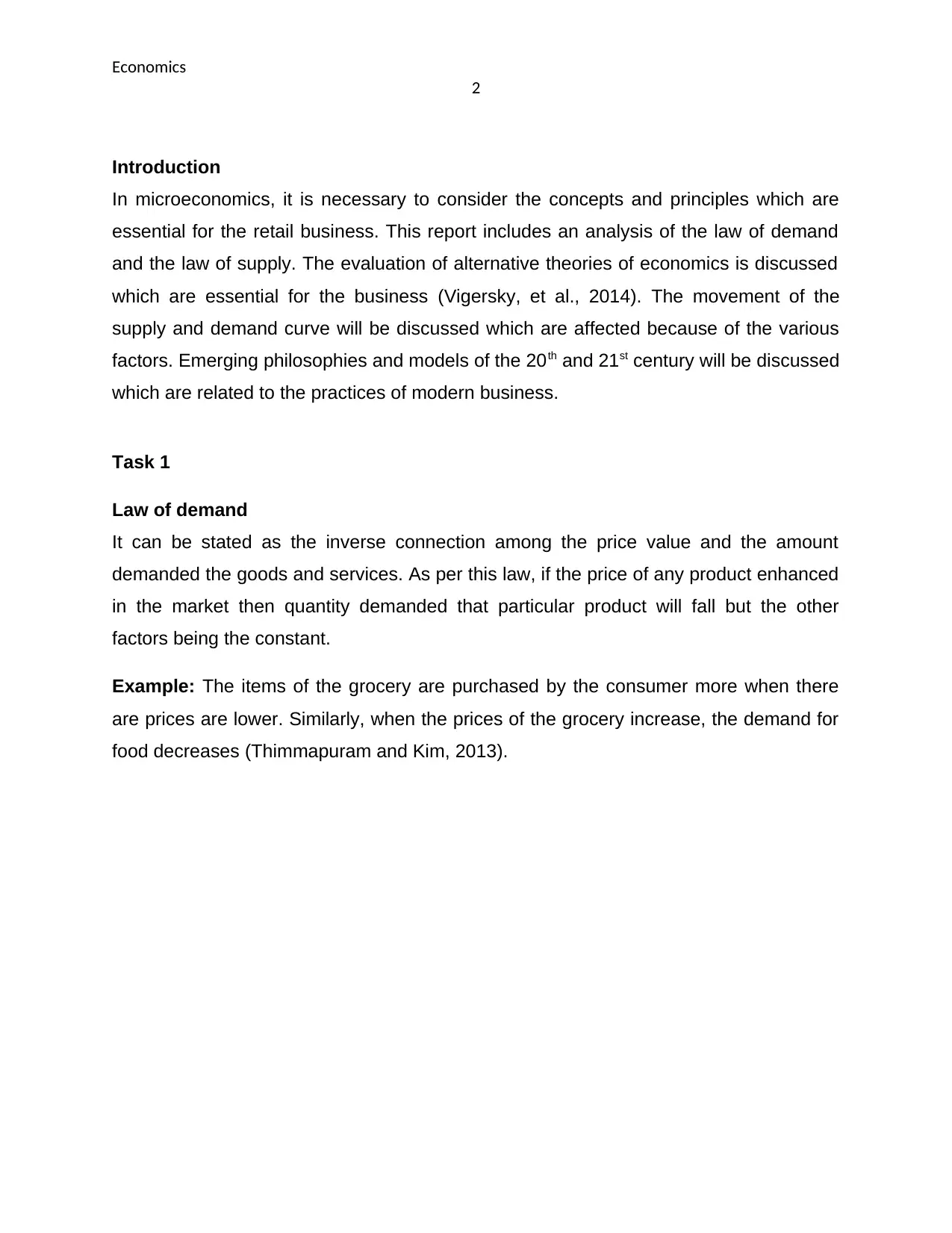
Economics
2
Introduction
In microeconomics, it is necessary to consider the concepts and principles which are
essential for the retail business. This report includes an analysis of the law of demand
and the law of supply. The evaluation of alternative theories of economics is discussed
which are essential for the business (Vigersky, et al., 2014). The movement of the
supply and demand curve will be discussed which are affected because of the various
factors. Emerging philosophies and models of the 20th and 21st century will be discussed
which are related to the practices of modern business.
Task 1
Law of demand
It can be stated as the inverse connection among the price value and the amount
demanded the goods and services. As per this law, if the price of any product enhanced
in the market then quantity demanded that particular product will fall but the other
factors being the constant.
Example: The items of the grocery are purchased by the consumer more when there
are prices are lower. Similarly, when the prices of the grocery increase, the demand for
food decreases (Thimmapuram and Kim, 2013).
2
Introduction
In microeconomics, it is necessary to consider the concepts and principles which are
essential for the retail business. This report includes an analysis of the law of demand
and the law of supply. The evaluation of alternative theories of economics is discussed
which are essential for the business (Vigersky, et al., 2014). The movement of the
supply and demand curve will be discussed which are affected because of the various
factors. Emerging philosophies and models of the 20th and 21st century will be discussed
which are related to the practices of modern business.
Task 1
Law of demand
It can be stated as the inverse connection among the price value and the amount
demanded the goods and services. As per this law, if the price of any product enhanced
in the market then quantity demanded that particular product will fall but the other
factors being the constant.
Example: The items of the grocery are purchased by the consumer more when there
are prices are lower. Similarly, when the prices of the grocery increase, the demand for
food decreases (Thimmapuram and Kim, 2013).
⊘ This is a preview!⊘
Do you want full access?
Subscribe today to unlock all pages.

Trusted by 1+ million students worldwide
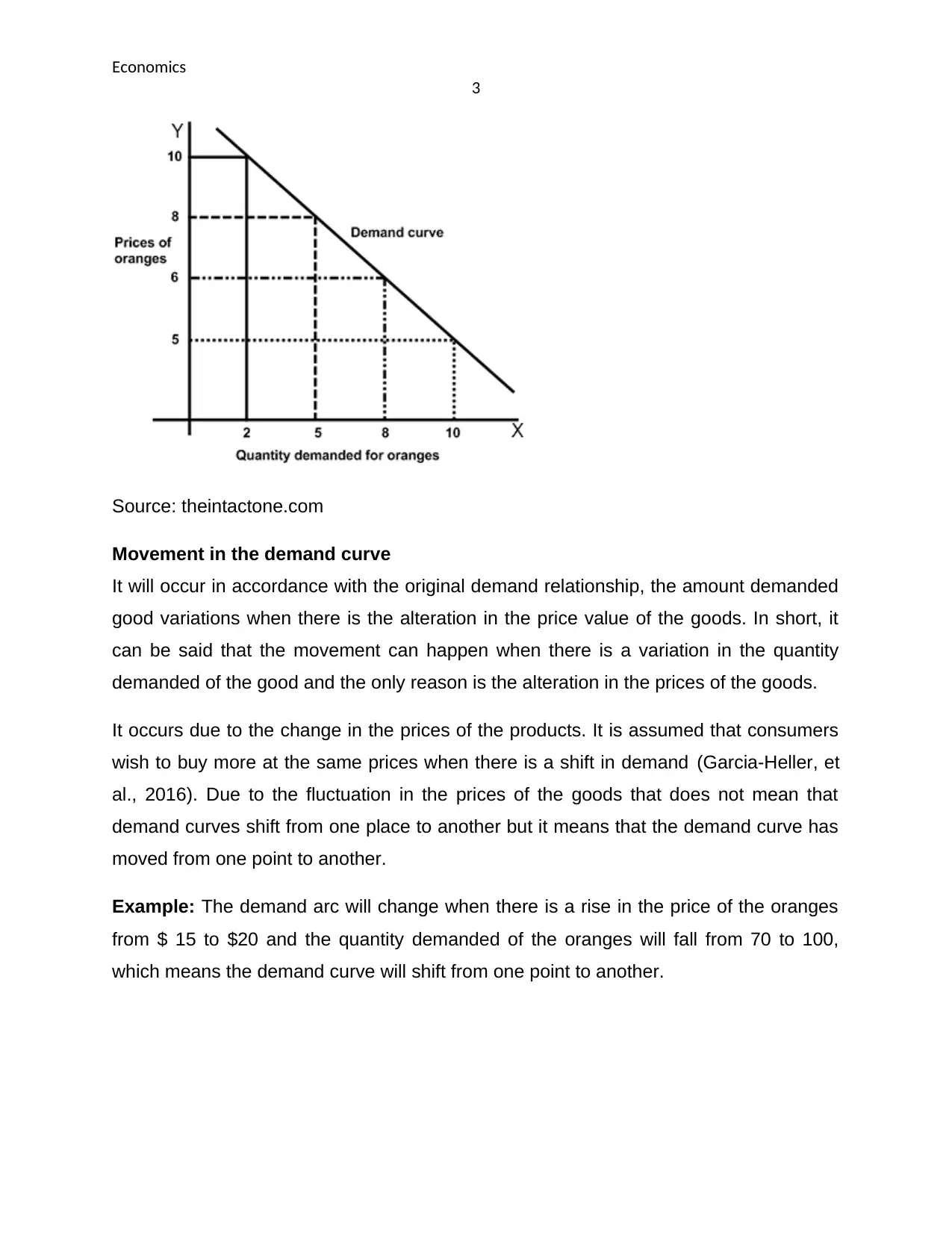
Economics
3
Source: theintactone.com
Movement in the demand curve
It will occur in accordance with the original demand relationship, the amount demanded
good variations when there is the alteration in the price value of the goods. In short, it
can be said that the movement can happen when there is a variation in the quantity
demanded of the good and the only reason is the alteration in the prices of the goods.
It occurs due to the change in the prices of the products. It is assumed that consumers
wish to buy more at the same prices when there is a shift in demand (Garcia-Heller, et
al., 2016). Due to the fluctuation in the prices of the goods that does not mean that
demand curves shift from one place to another but it means that the demand curve has
moved from one point to another.
Example: The demand arc will change when there is a rise in the price of the oranges
from $ 15 to $20 and the quantity demanded of the oranges will fall from 70 to 100,
which means the demand curve will shift from one point to another.
3
Source: theintactone.com
Movement in the demand curve
It will occur in accordance with the original demand relationship, the amount demanded
good variations when there is the alteration in the price value of the goods. In short, it
can be said that the movement can happen when there is a variation in the quantity
demanded of the good and the only reason is the alteration in the prices of the goods.
It occurs due to the change in the prices of the products. It is assumed that consumers
wish to buy more at the same prices when there is a shift in demand (Garcia-Heller, et
al., 2016). Due to the fluctuation in the prices of the goods that does not mean that
demand curves shift from one place to another but it means that the demand curve has
moved from one point to another.
Example: The demand arc will change when there is a rise in the price of the oranges
from $ 15 to $20 and the quantity demanded of the oranges will fall from 70 to 100,
which means the demand curve will shift from one point to another.
Paraphrase This Document
Need a fresh take? Get an instant paraphrase of this document with our AI Paraphraser
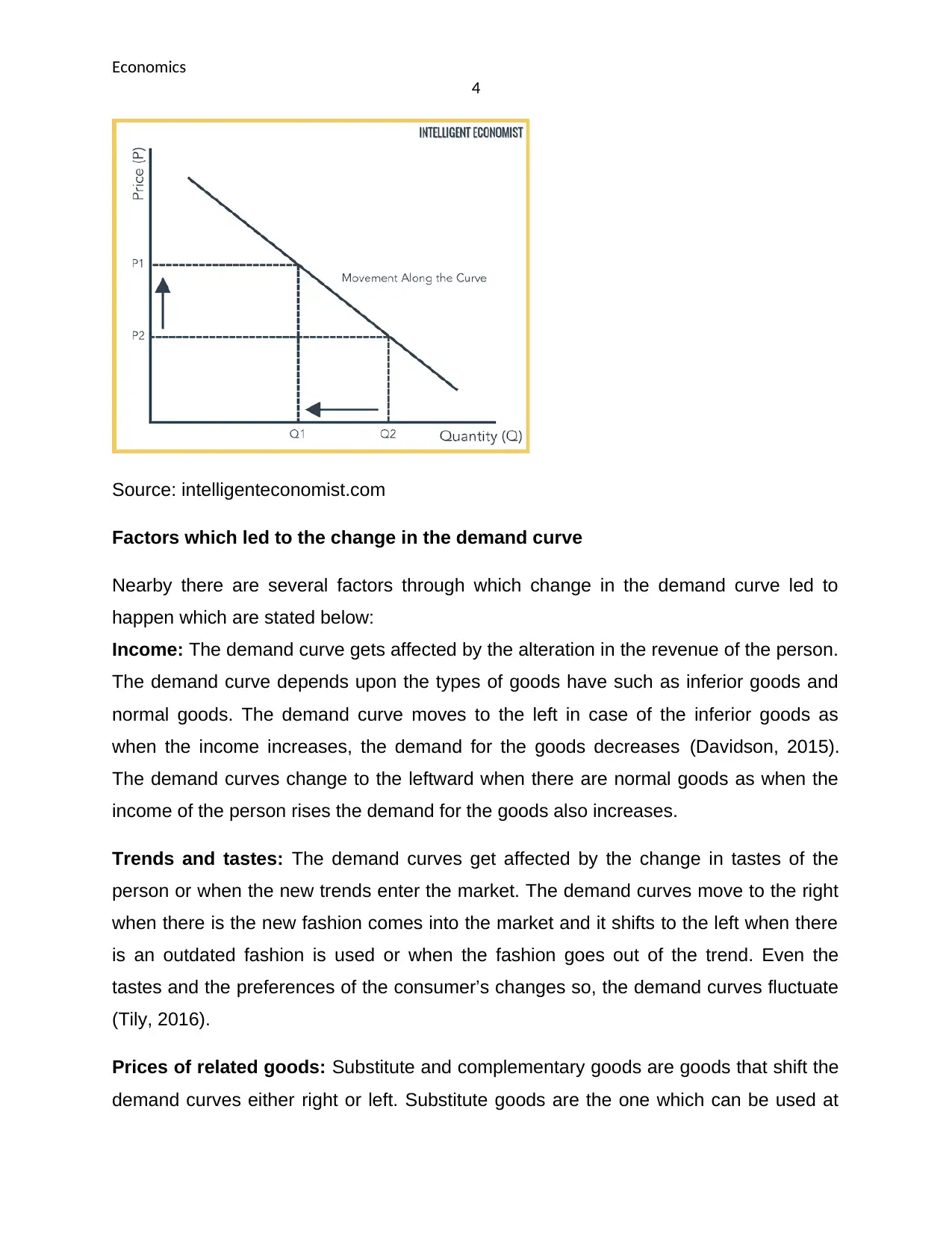
Economics
4
Source: intelligenteconomist.com
Factors which led to the change in the demand curve
Nearby there are several factors through which change in the demand curve led to
happen which are stated below:
Income: The demand curve gets affected by the alteration in the revenue of the person.
The demand curve depends upon the types of goods have such as inferior goods and
normal goods. The demand curve moves to the left in case of the inferior goods as
when the income increases, the demand for the goods decreases (Davidson, 2015).
The demand curves change to the leftward when there are normal goods as when the
income of the person rises the demand for the goods also increases.
Trends and tastes: The demand curves get affected by the change in tastes of the
person or when the new trends enter the market. The demand curves move to the right
when there is the new fashion comes into the market and it shifts to the left when there
is an outdated fashion is used or when the fashion goes out of the trend. Even the
tastes and the preferences of the consumer’s changes so, the demand curves fluctuate
(Tily, 2016).
Prices of related goods: Substitute and complementary goods are goods that shift the
demand curves either right or left. Substitute goods are the one which can be used at
4
Source: intelligenteconomist.com
Factors which led to the change in the demand curve
Nearby there are several factors through which change in the demand curve led to
happen which are stated below:
Income: The demand curve gets affected by the alteration in the revenue of the person.
The demand curve depends upon the types of goods have such as inferior goods and
normal goods. The demand curve moves to the left in case of the inferior goods as
when the income increases, the demand for the goods decreases (Davidson, 2015).
The demand curves change to the leftward when there are normal goods as when the
income of the person rises the demand for the goods also increases.
Trends and tastes: The demand curves get affected by the change in tastes of the
person or when the new trends enter the market. The demand curves move to the right
when there is the new fashion comes into the market and it shifts to the left when there
is an outdated fashion is used or when the fashion goes out of the trend. Even the
tastes and the preferences of the consumer’s changes so, the demand curves fluctuate
(Tily, 2016).
Prices of related goods: Substitute and complementary goods are goods that shift the
demand curves either right or left. Substitute goods are the one which can be used at
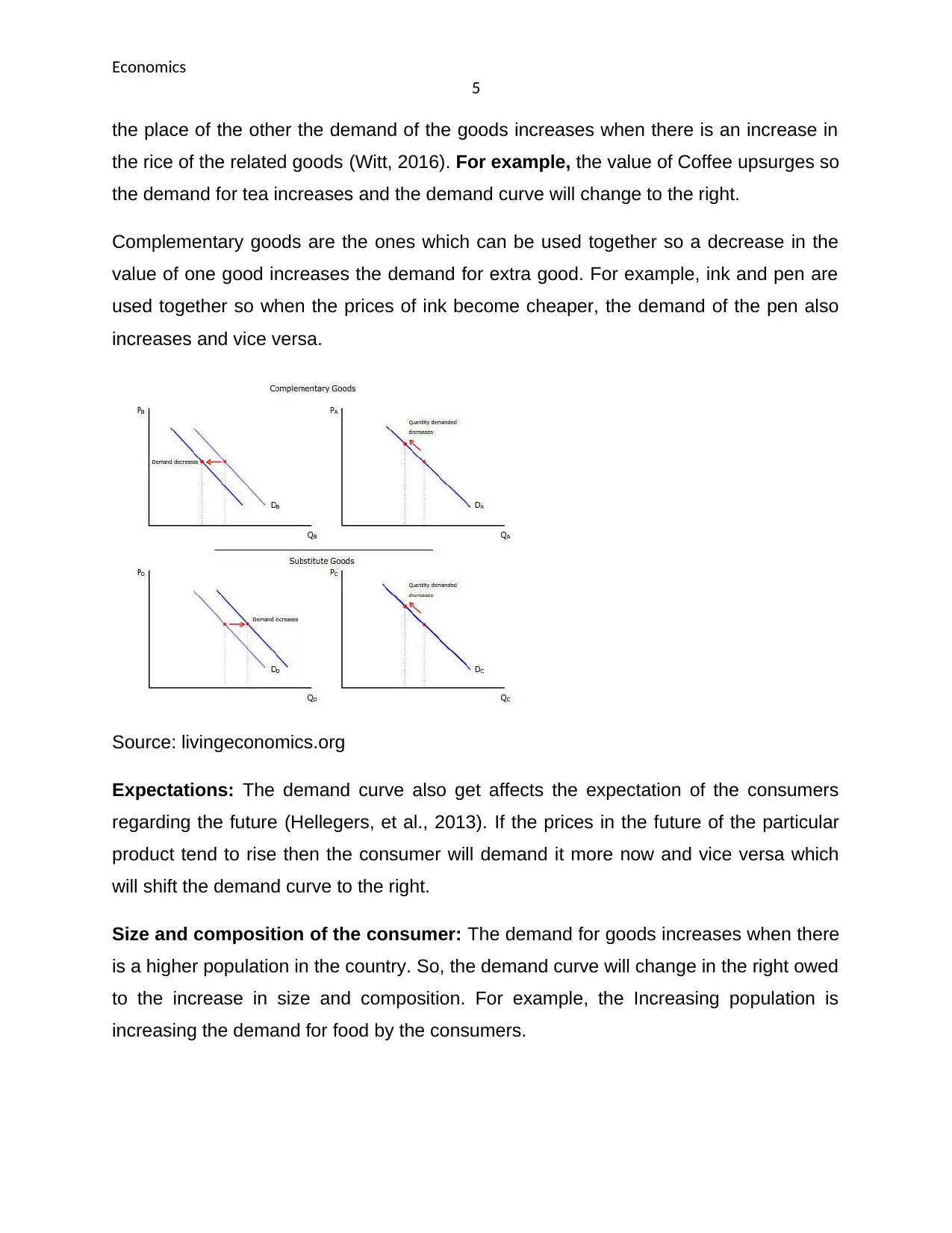
Economics
5
the place of the other the demand of the goods increases when there is an increase in
the rice of the related goods (Witt, 2016). For example, the value of Coffee upsurges so
the demand for tea increases and the demand curve will change to the right.
Complementary goods are the ones which can be used together so a decrease in the
value of one good increases the demand for extra good. For example, ink and pen are
used together so when the prices of ink become cheaper, the demand of the pen also
increases and vice versa.
Source: livingeconomics.org
Expectations: The demand curve also get affects the expectation of the consumers
regarding the future (Hellegers, et al., 2013). If the prices in the future of the particular
product tend to rise then the consumer will demand it more now and vice versa which
will shift the demand curve to the right.
Size and composition of the consumer: The demand for goods increases when there
is a higher population in the country. So, the demand curve will change in the right owed
to the increase in size and composition. For example, the Increasing population is
increasing the demand for food by the consumers.
5
the place of the other the demand of the goods increases when there is an increase in
the rice of the related goods (Witt, 2016). For example, the value of Coffee upsurges so
the demand for tea increases and the demand curve will change to the right.
Complementary goods are the ones which can be used together so a decrease in the
value of one good increases the demand for extra good. For example, ink and pen are
used together so when the prices of ink become cheaper, the demand of the pen also
increases and vice versa.
Source: livingeconomics.org
Expectations: The demand curve also get affects the expectation of the consumers
regarding the future (Hellegers, et al., 2013). If the prices in the future of the particular
product tend to rise then the consumer will demand it more now and vice versa which
will shift the demand curve to the right.
Size and composition of the consumer: The demand for goods increases when there
is a higher population in the country. So, the demand curve will change in the right owed
to the increase in size and composition. For example, the Increasing population is
increasing the demand for food by the consumers.
⊘ This is a preview!⊘
Do you want full access?
Subscribe today to unlock all pages.

Trusted by 1+ million students worldwide
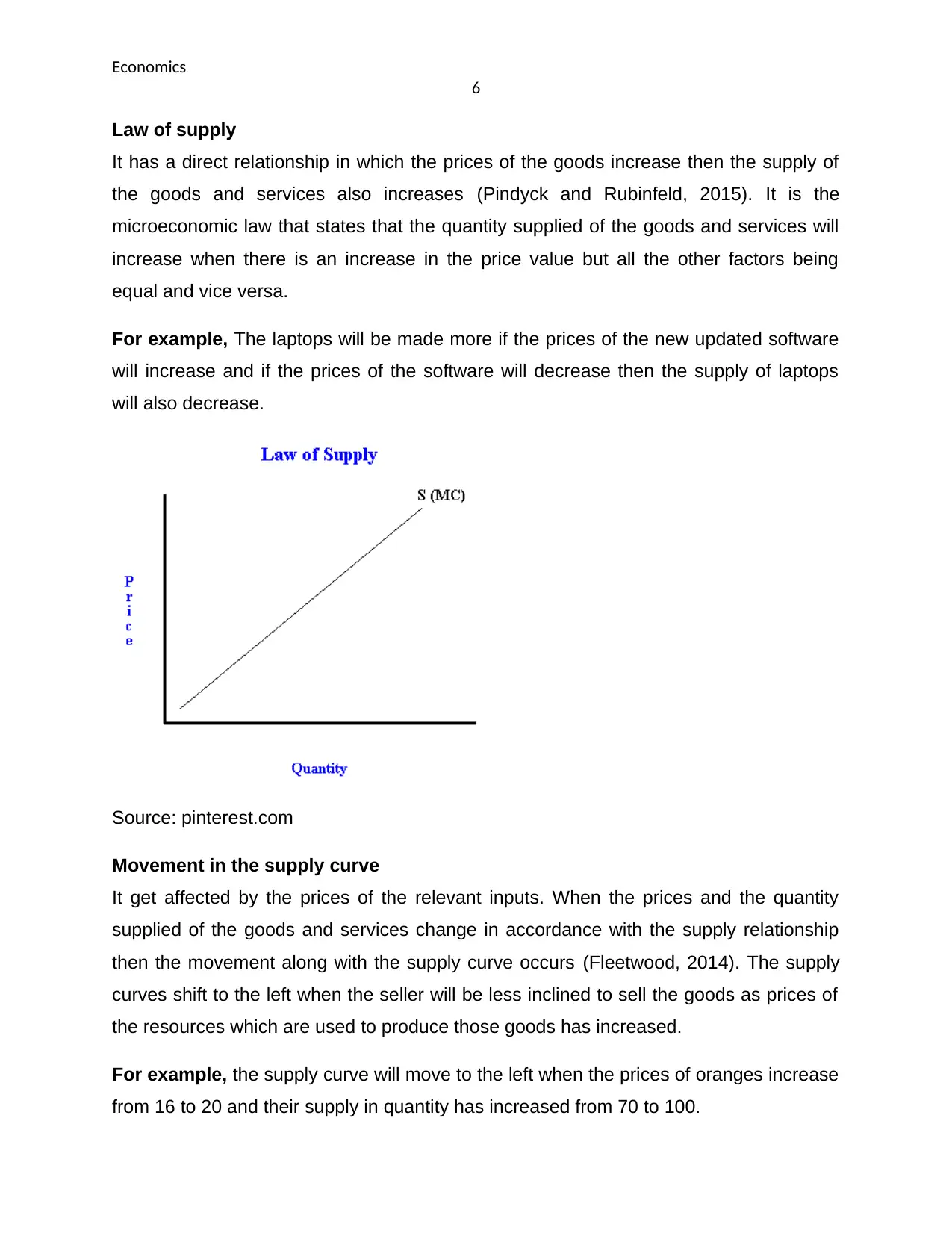
Economics
6
Law of supply
It has a direct relationship in which the prices of the goods increase then the supply of
the goods and services also increases (Pindyck and Rubinfeld, 2015). It is the
microeconomic law that states that the quantity supplied of the goods and services will
increase when there is an increase in the price value but all the other factors being
equal and vice versa.
For example, The laptops will be made more if the prices of the new updated software
will increase and if the prices of the software will decrease then the supply of laptops
will also decrease.
Source: pinterest.com
Movement in the supply curve
It get affected by the prices of the relevant inputs. When the prices and the quantity
supplied of the goods and services change in accordance with the supply relationship
then the movement along with the supply curve occurs (Fleetwood, 2014). The supply
curves shift to the left when the seller will be less inclined to sell the goods as prices of
the resources which are used to produce those goods has increased.
For example, the supply curve will move to the left when the prices of oranges increase
from 16 to 20 and their supply in quantity has increased from 70 to 100.
6
Law of supply
It has a direct relationship in which the prices of the goods increase then the supply of
the goods and services also increases (Pindyck and Rubinfeld, 2015). It is the
microeconomic law that states that the quantity supplied of the goods and services will
increase when there is an increase in the price value but all the other factors being
equal and vice versa.
For example, The laptops will be made more if the prices of the new updated software
will increase and if the prices of the software will decrease then the supply of laptops
will also decrease.
Source: pinterest.com
Movement in the supply curve
It get affected by the prices of the relevant inputs. When the prices and the quantity
supplied of the goods and services change in accordance with the supply relationship
then the movement along with the supply curve occurs (Fleetwood, 2014). The supply
curves shift to the left when the seller will be less inclined to sell the goods as prices of
the resources which are used to produce those goods has increased.
For example, the supply curve will move to the left when the prices of oranges increase
from 16 to 20 and their supply in quantity has increased from 70 to 100.
Paraphrase This Document
Need a fresh take? Get an instant paraphrase of this document with our AI Paraphraser
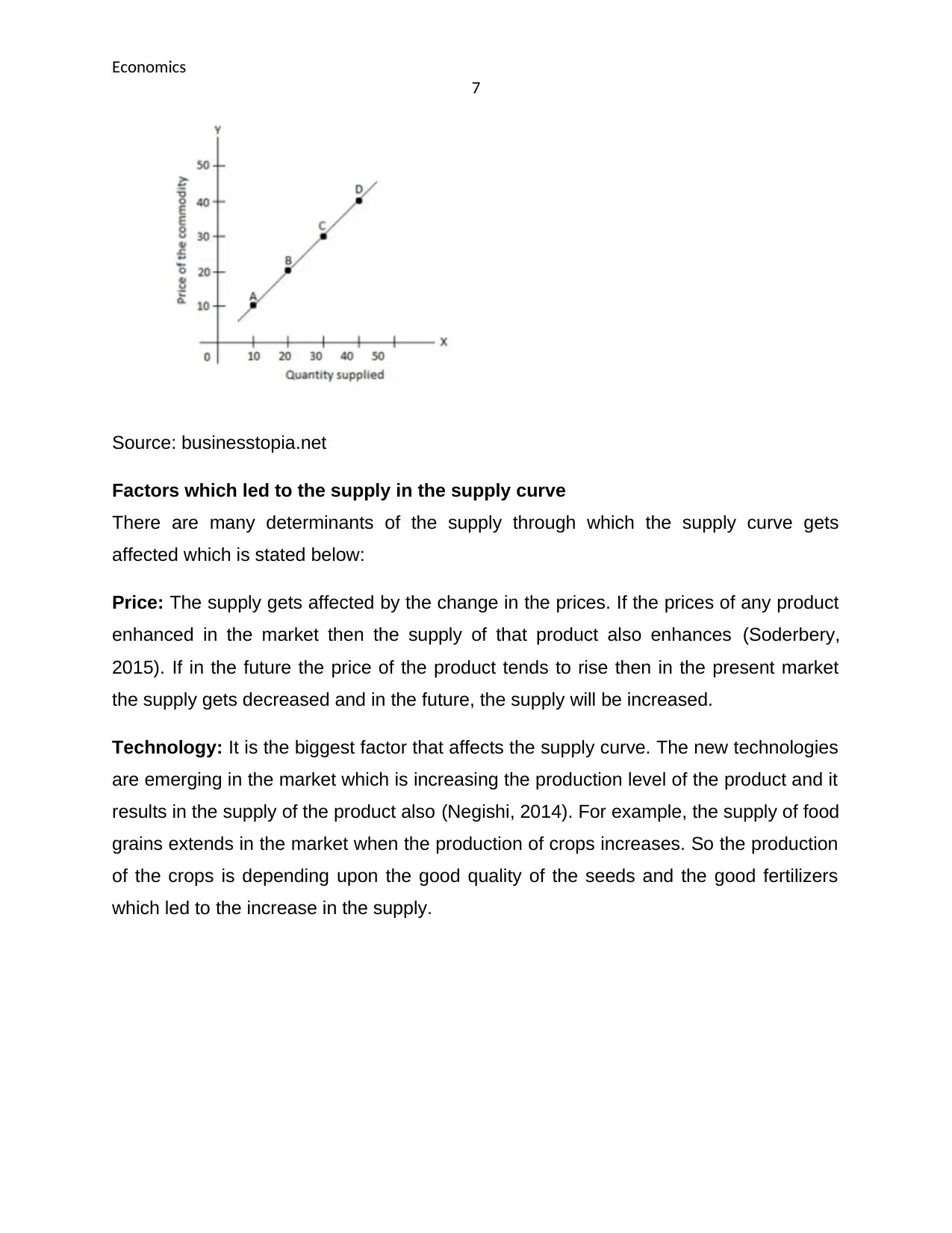
Economics
7
Source: businesstopia.net
Factors which led to the supply in the supply curve
There are many determinants of the supply through which the supply curve gets
affected which is stated below:
Price: The supply gets affected by the change in the prices. If the prices of any product
enhanced in the market then the supply of that product also enhances (Soderbery,
2015). If in the future the price of the product tends to rise then in the present market
the supply gets decreased and in the future, the supply will be increased.
Technology: It is the biggest factor that affects the supply curve. The new technologies
are emerging in the market which is increasing the production level of the product and it
results in the supply of the product also (Negishi, 2014). For example, the supply of food
grains extends in the market when the production of crops increases. So the production
of the crops is depending upon the good quality of the seeds and the good fertilizers
which led to the increase in the supply.
7
Source: businesstopia.net
Factors which led to the supply in the supply curve
There are many determinants of the supply through which the supply curve gets
affected which is stated below:
Price: The supply gets affected by the change in the prices. If the prices of any product
enhanced in the market then the supply of that product also enhances (Soderbery,
2015). If in the future the price of the product tends to rise then in the present market
the supply gets decreased and in the future, the supply will be increased.
Technology: It is the biggest factor that affects the supply curve. The new technologies
are emerging in the market which is increasing the production level of the product and it
results in the supply of the product also (Negishi, 2014). For example, the supply of food
grains extends in the market when the production of crops increases. So the production
of the crops is depending upon the good quality of the seeds and the good fertilizers
which led to the increase in the supply.
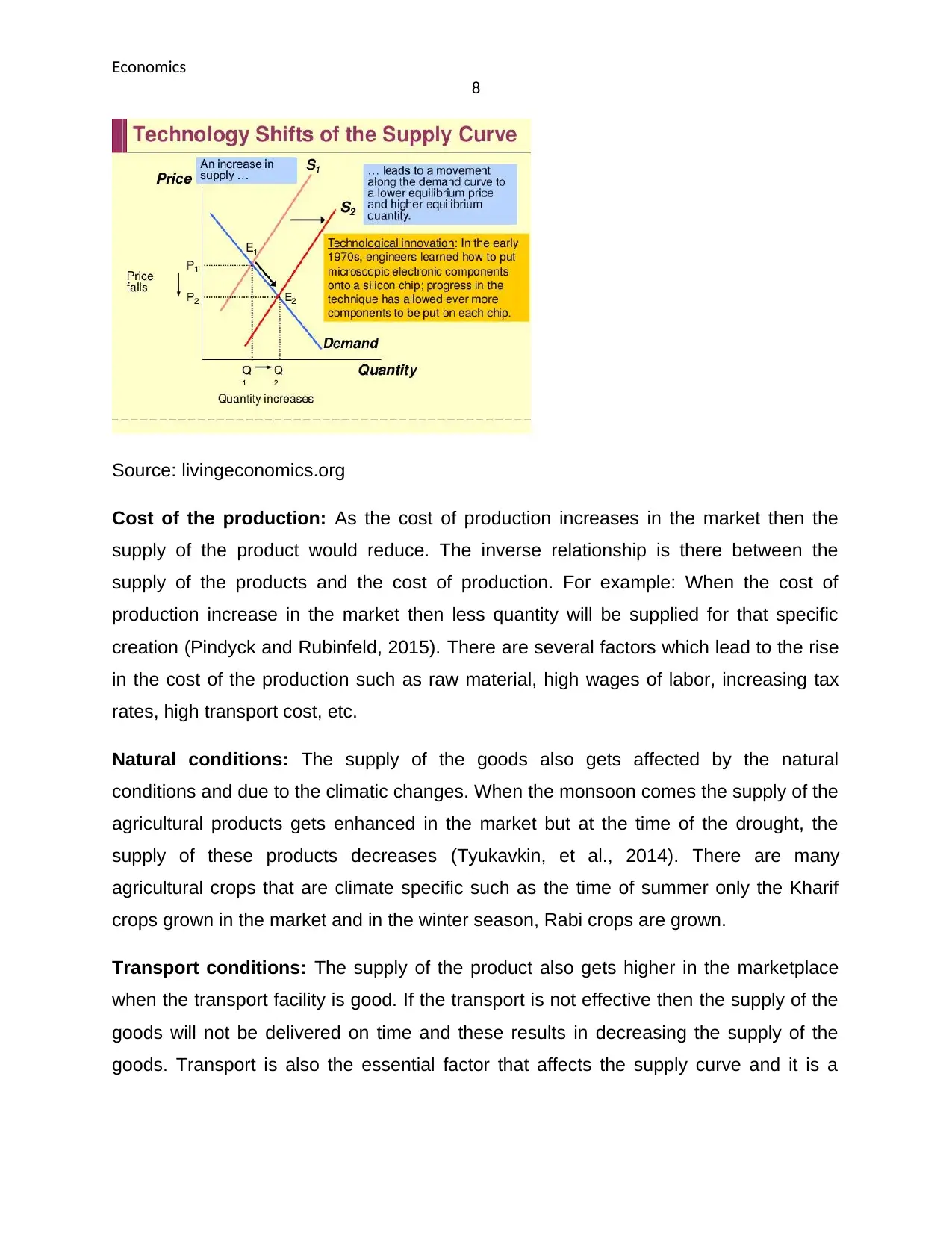
Economics
8
Source: livingeconomics.org
Cost of the production: As the cost of production increases in the market then the
supply of the product would reduce. The inverse relationship is there between the
supply of the products and the cost of production. For example: When the cost of
production increase in the market then less quantity will be supplied for that specific
creation (Pindyck and Rubinfeld, 2015). There are several factors which lead to the rise
in the cost of the production such as raw material, high wages of labor, increasing tax
rates, high transport cost, etc.
Natural conditions: The supply of the goods also gets affected by the natural
conditions and due to the climatic changes. When the monsoon comes the supply of the
agricultural products gets enhanced in the market but at the time of the drought, the
supply of these products decreases (Tyukavkin, et al., 2014). There are many
agricultural crops that are climate specific such as the time of summer only the Kharif
crops grown in the market and in the winter season, Rabi crops are grown.
Transport conditions: The supply of the product also gets higher in the marketplace
when the transport facility is good. If the transport is not effective then the supply of the
goods will not be delivered on time and these results in decreasing the supply of the
goods. Transport is also the essential factor that affects the supply curve and it is a
8
Source: livingeconomics.org
Cost of the production: As the cost of production increases in the market then the
supply of the product would reduce. The inverse relationship is there between the
supply of the products and the cost of production. For example: When the cost of
production increase in the market then less quantity will be supplied for that specific
creation (Pindyck and Rubinfeld, 2015). There are several factors which lead to the rise
in the cost of the production such as raw material, high wages of labor, increasing tax
rates, high transport cost, etc.
Natural conditions: The supply of the goods also gets affected by the natural
conditions and due to the climatic changes. When the monsoon comes the supply of the
agricultural products gets enhanced in the market but at the time of the drought, the
supply of these products decreases (Tyukavkin, et al., 2014). There are many
agricultural crops that are climate specific such as the time of summer only the Kharif
crops grown in the market and in the winter season, Rabi crops are grown.
Transport conditions: The supply of the product also gets higher in the marketplace
when the transport facility is good. If the transport is not effective then the supply of the
goods will not be delivered on time and these results in decreasing the supply of the
goods. Transport is also the essential factor that affects the supply curve and it is a
⊘ This is a preview!⊘
Do you want full access?
Subscribe today to unlock all pages.

Trusted by 1+ million students worldwide
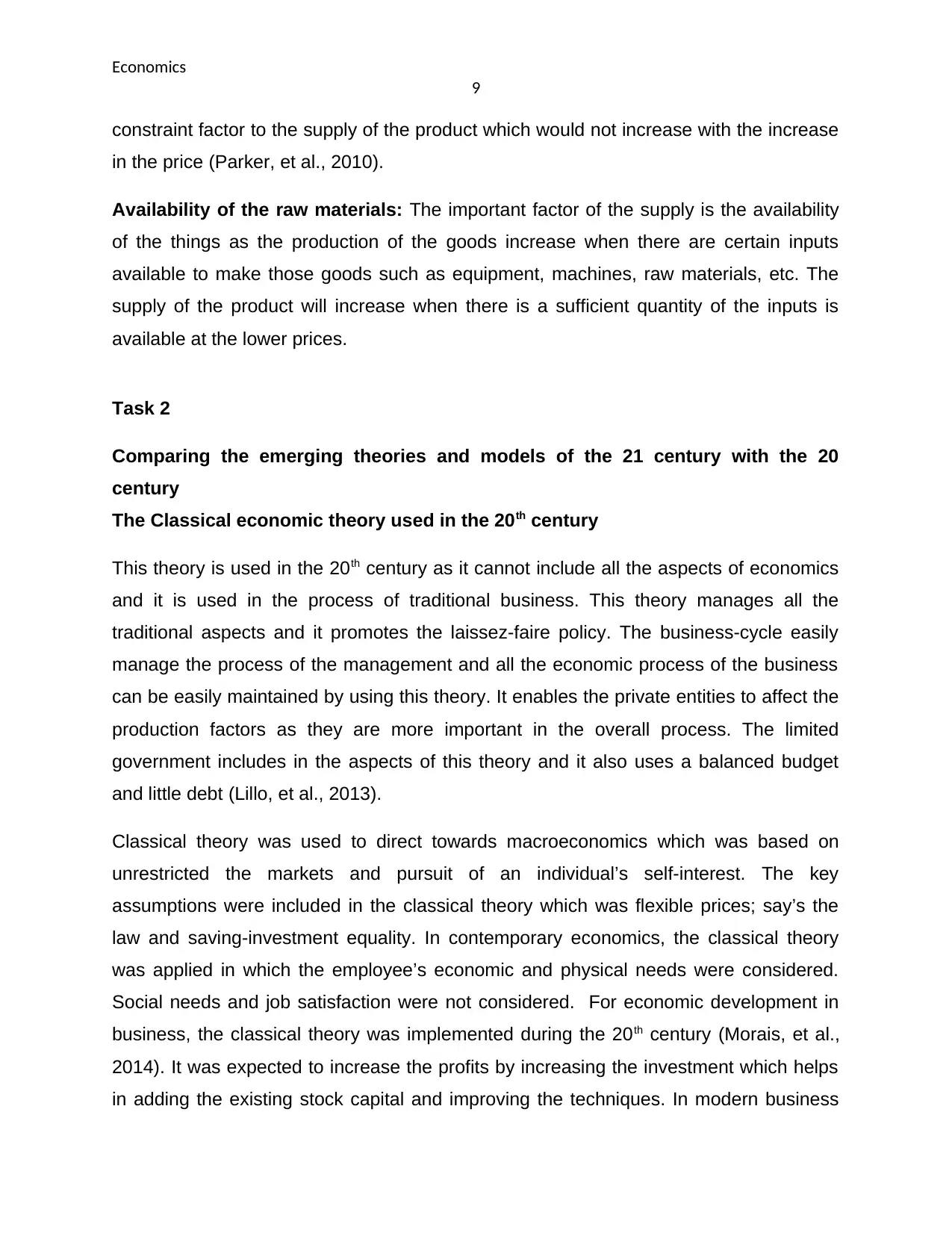
Economics
9
constraint factor to the supply of the product which would not increase with the increase
in the price (Parker, et al., 2010).
Availability of the raw materials: The important factor of the supply is the availability
of the things as the production of the goods increase when there are certain inputs
available to make those goods such as equipment, machines, raw materials, etc. The
supply of the product will increase when there is a sufficient quantity of the inputs is
available at the lower prices.
Task 2
Comparing the emerging theories and models of the 21 century with the 20
century
The Classical economic theory used in the 20th century
This theory is used in the 20th century as it cannot include all the aspects of economics
and it is used in the process of traditional business. This theory manages all the
traditional aspects and it promotes the laissez-faire policy. The business-cycle easily
manage the process of the management and all the economic process of the business
can be easily maintained by using this theory. It enables the private entities to affect the
production factors as they are more important in the overall process. The limited
government includes in the aspects of this theory and it also uses a balanced budget
and little debt (Lillo, et al., 2013).
Classical theory was used to direct towards macroeconomics which was based on
unrestricted the markets and pursuit of an individual’s self-interest. The key
assumptions were included in the classical theory which was flexible prices; say’s the
law and saving-investment equality. In contemporary economics, the classical theory
was applied in which the employee’s economic and physical needs were considered.
Social needs and job satisfaction were not considered. For economic development in
business, the classical theory was implemented during the 20th century (Morais, et al.,
2014). It was expected to increase the profits by increasing the investment which helps
in adding the existing stock capital and improving the techniques. In modern business
9
constraint factor to the supply of the product which would not increase with the increase
in the price (Parker, et al., 2010).
Availability of the raw materials: The important factor of the supply is the availability
of the things as the production of the goods increase when there are certain inputs
available to make those goods such as equipment, machines, raw materials, etc. The
supply of the product will increase when there is a sufficient quantity of the inputs is
available at the lower prices.
Task 2
Comparing the emerging theories and models of the 21 century with the 20
century
The Classical economic theory used in the 20th century
This theory is used in the 20th century as it cannot include all the aspects of economics
and it is used in the process of traditional business. This theory manages all the
traditional aspects and it promotes the laissez-faire policy. The business-cycle easily
manage the process of the management and all the economic process of the business
can be easily maintained by using this theory. It enables the private entities to affect the
production factors as they are more important in the overall process. The limited
government includes in the aspects of this theory and it also uses a balanced budget
and little debt (Lillo, et al., 2013).
Classical theory was used to direct towards macroeconomics which was based on
unrestricted the markets and pursuit of an individual’s self-interest. The key
assumptions were included in the classical theory which was flexible prices; say’s the
law and saving-investment equality. In contemporary economics, the classical theory
was applied in which the employee’s economic and physical needs were considered.
Social needs and job satisfaction were not considered. For economic development in
business, the classical theory was implemented during the 20th century (Morais, et al.,
2014). It was expected to increase the profits by increasing the investment which helps
in adding the existing stock capital and improving the techniques. In modern business
Paraphrase This Document
Need a fresh take? Get an instant paraphrase of this document with our AI Paraphraser
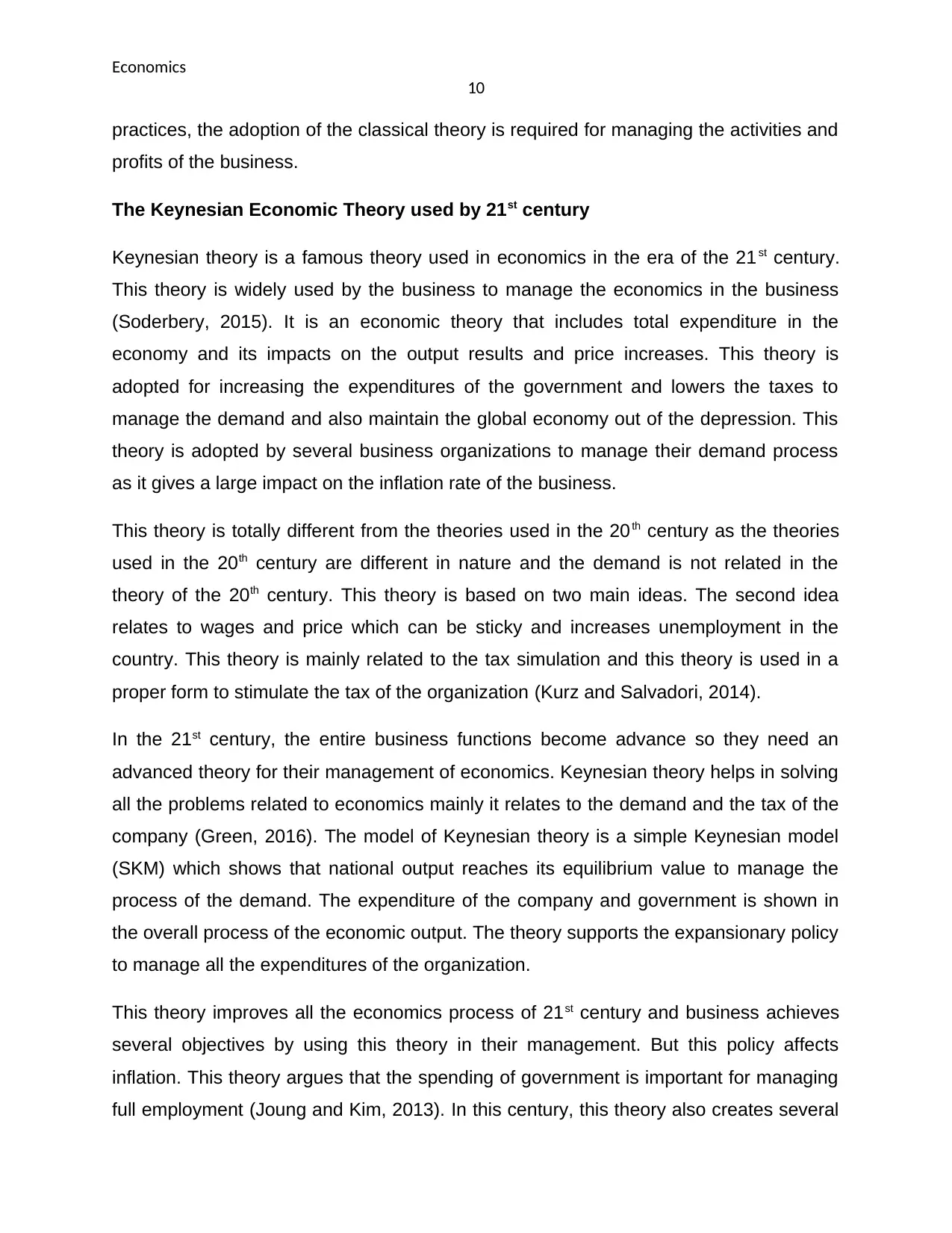
Economics
10
practices, the adoption of the classical theory is required for managing the activities and
profits of the business.
The Keynesian Economic Theory used by 21st century
Keynesian theory is a famous theory used in economics in the era of the 21 st century.
This theory is widely used by the business to manage the economics in the business
(Soderbery, 2015). It is an economic theory that includes total expenditure in the
economy and its impacts on the output results and price increases. This theory is
adopted for increasing the expenditures of the government and lowers the taxes to
manage the demand and also maintain the global economy out of the depression. This
theory is adopted by several business organizations to manage their demand process
as it gives a large impact on the inflation rate of the business.
This theory is totally different from the theories used in the 20th century as the theories
used in the 20th century are different in nature and the demand is not related in the
theory of the 20th century. This theory is based on two main ideas. The second idea
relates to wages and price which can be sticky and increases unemployment in the
country. This theory is mainly related to the tax simulation and this theory is used in a
proper form to stimulate the tax of the organization (Kurz and Salvadori, 2014).
In the 21st century, the entire business functions become advance so they need an
advanced theory for their management of economics. Keynesian theory helps in solving
all the problems related to economics mainly it relates to the demand and the tax of the
company (Green, 2016). The model of Keynesian theory is a simple Keynesian model
(SKM) which shows that national output reaches its equilibrium value to manage the
process of the demand. The expenditure of the company and government is shown in
the overall process of the economic output. The theory supports the expansionary policy
to manage all the expenditures of the organization.
This theory improves all the economics process of 21st century and business achieves
several objectives by using this theory in their management. But this policy affects
inflation. This theory argues that the spending of government is important for managing
full employment (Joung and Kim, 2013). In this century, this theory also creates several
10
practices, the adoption of the classical theory is required for managing the activities and
profits of the business.
The Keynesian Economic Theory used by 21st century
Keynesian theory is a famous theory used in economics in the era of the 21 st century.
This theory is widely used by the business to manage the economics in the business
(Soderbery, 2015). It is an economic theory that includes total expenditure in the
economy and its impacts on the output results and price increases. This theory is
adopted for increasing the expenditures of the government and lowers the taxes to
manage the demand and also maintain the global economy out of the depression. This
theory is adopted by several business organizations to manage their demand process
as it gives a large impact on the inflation rate of the business.
This theory is totally different from the theories used in the 20th century as the theories
used in the 20th century are different in nature and the demand is not related in the
theory of the 20th century. This theory is based on two main ideas. The second idea
relates to wages and price which can be sticky and increases unemployment in the
country. This theory is mainly related to the tax simulation and this theory is used in a
proper form to stimulate the tax of the organization (Kurz and Salvadori, 2014).
In the 21st century, the entire business functions become advance so they need an
advanced theory for their management of economics. Keynesian theory helps in solving
all the problems related to economics mainly it relates to the demand and the tax of the
company (Green, 2016). The model of Keynesian theory is a simple Keynesian model
(SKM) which shows that national output reaches its equilibrium value to manage the
process of the demand. The expenditure of the company and government is shown in
the overall process of the economic output. The theory supports the expansionary policy
to manage all the expenditures of the organization.
This theory improves all the economics process of 21st century and business achieves
several objectives by using this theory in their management. But this policy affects
inflation. This theory argues that the spending of government is important for managing
full employment (Joung and Kim, 2013). In this century, this theory also creates several
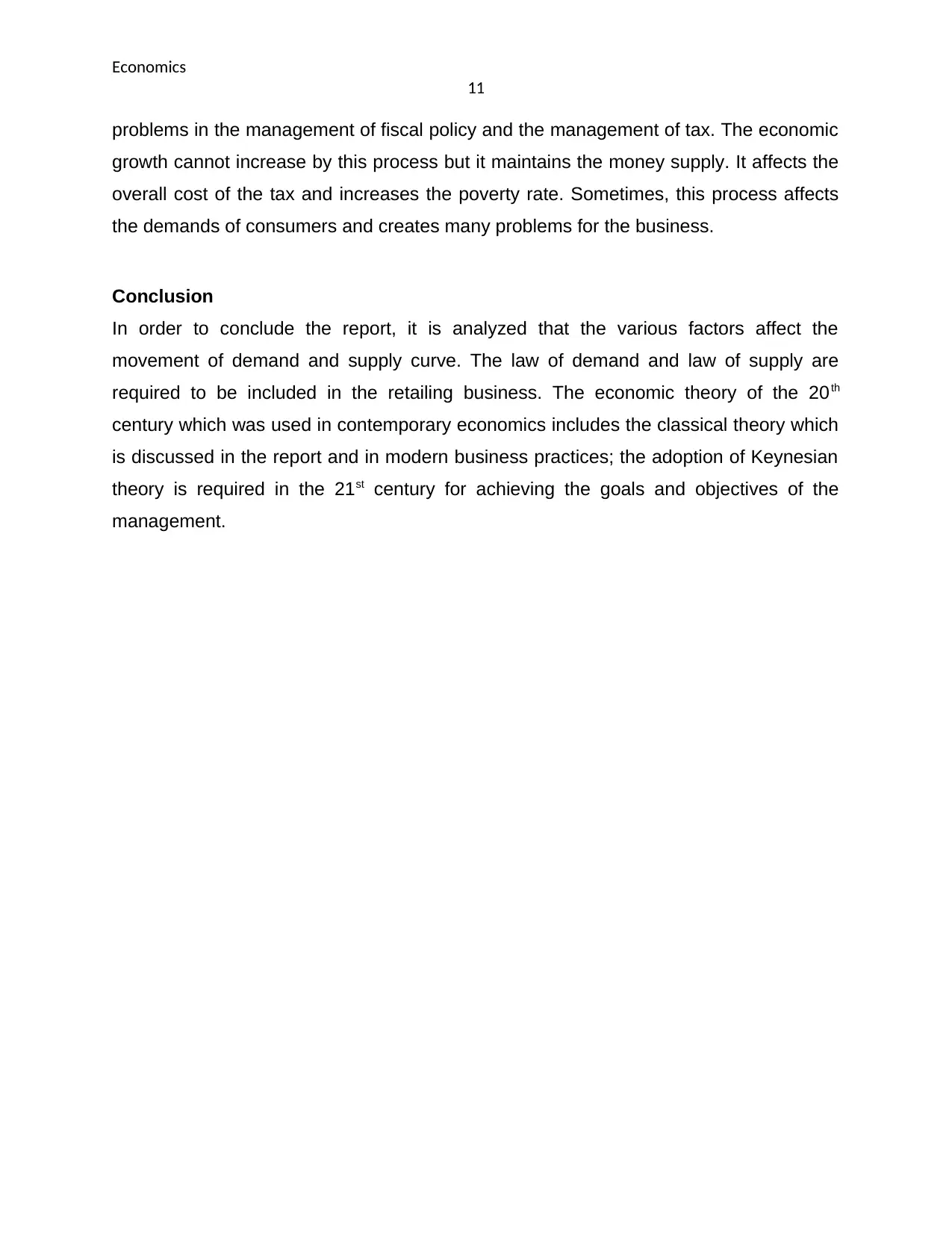
Economics
11
problems in the management of fiscal policy and the management of tax. The economic
growth cannot increase by this process but it maintains the money supply. It affects the
overall cost of the tax and increases the poverty rate. Sometimes, this process affects
the demands of consumers and creates many problems for the business.
Conclusion
In order to conclude the report, it is analyzed that the various factors affect the
movement of demand and supply curve. The law of demand and law of supply are
required to be included in the retailing business. The economic theory of the 20th
century which was used in contemporary economics includes the classical theory which
is discussed in the report and in modern business practices; the adoption of Keynesian
theory is required in the 21st century for achieving the goals and objectives of the
management.
11
problems in the management of fiscal policy and the management of tax. The economic
growth cannot increase by this process but it maintains the money supply. It affects the
overall cost of the tax and increases the poverty rate. Sometimes, this process affects
the demands of consumers and creates many problems for the business.
Conclusion
In order to conclude the report, it is analyzed that the various factors affect the
movement of demand and supply curve. The law of demand and law of supply are
required to be included in the retailing business. The economic theory of the 20th
century which was used in contemporary economics includes the classical theory which
is discussed in the report and in modern business practices; the adoption of Keynesian
theory is required in the 21st century for achieving the goals and objectives of the
management.
⊘ This is a preview!⊘
Do you want full access?
Subscribe today to unlock all pages.

Trusted by 1+ million students worldwide
1 out of 14
Related Documents
Your All-in-One AI-Powered Toolkit for Academic Success.
+13062052269
info@desklib.com
Available 24*7 on WhatsApp / Email
![[object Object]](/_next/static/media/star-bottom.7253800d.svg)
Unlock your academic potential
Copyright © 2020–2025 A2Z Services. All Rights Reserved. Developed and managed by ZUCOL.





